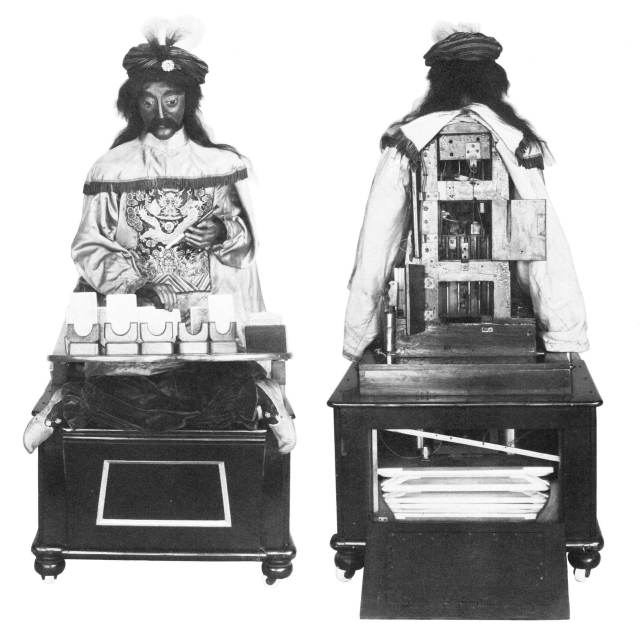
"Psycho" at the Museum of Science, London. (Image source: Mechanical Toys – Charles Bartholomew)
My intent in putting up this entry is to draw attention on the aspect of remote control by which the slave component is anthropomorphic. This fits in with the early history of teleoperators and manipulators. All other aspects of "Psycho" are well covered on the net and in books already, well beyond my capability, available time, and need.
This remote control shows early thinking using available technology on the problem of how to manipulate an anthropomorphic arm by remote, and in this case, quite novel means.
Whilst Maskelyne's "Psycho" was the first Whist-Player, my two main sources are based on the Whist-player published in Will Goldston's book "Exclusive Magical Secrets" 1912 and Vere's 1879 book Ancient and Modern Magic. My copy of Goldston's book is a mass produced paperback version published by Coles. Goldston states that his description is based on the property of A.W. Gamage, Ltd. Gamage were suppliers of apparatus as well as publishers.
"Psycho" was first exposed by Dr. W. Pole [a writer of card playing strategies] in January of 1876 [RH: actually published for the Christmas edition, which is the January edition] who became aware of the existance of Maskelyne's and Cooke's new Whist-playing automaton act, and published his description in McMillan's Magazine. (see MacMillan's pdf here).
Note: RH Jan 2011 The patent only gained a provisional protection and there were no published drawings with it. See patent details here.
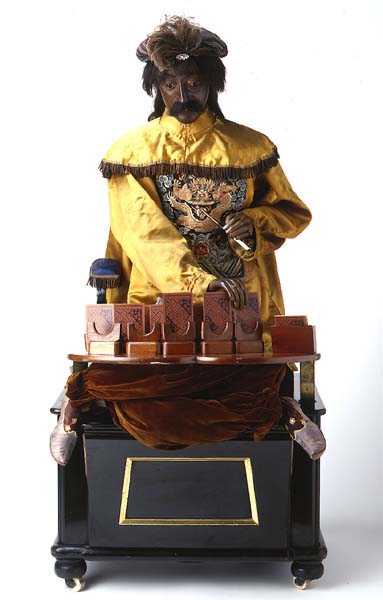
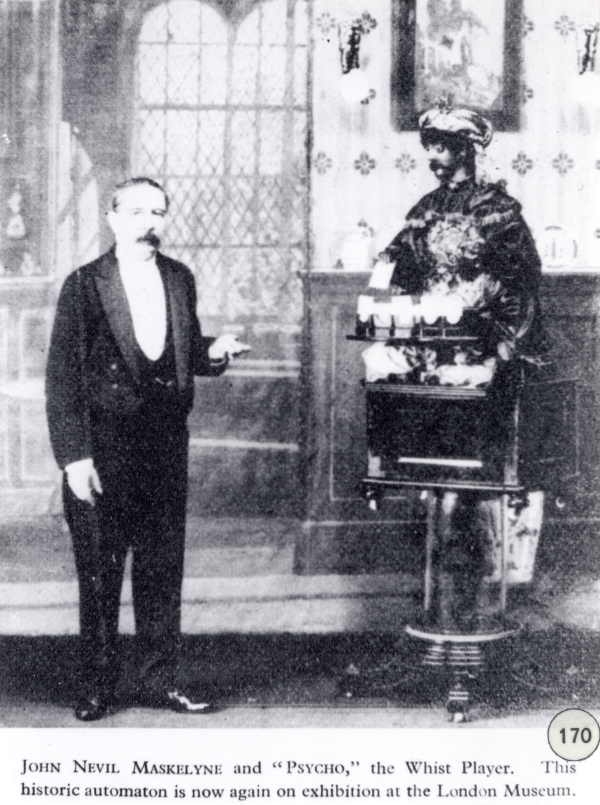
Note: RH Jan 2011 My research to date has not revealed anyone who has mentioned that the "Psycho's" pictured with Maskylene above and below are actually different. The number of cards on display has been reduced from 13 to 5, and the panels in the cabinetry are different. The base is different too, hence the change in overall height.
[UPATE 8 JUNE 2011 – Maria (see comments below) advises that Psycho as he is seen today still shows 13 cards, but they are laid out in 3 rows now. the front row furthest away from him holds 5 cards in a slight arc, as does the second row and the third row nearest his body holds 3. – Thanks Maria!]
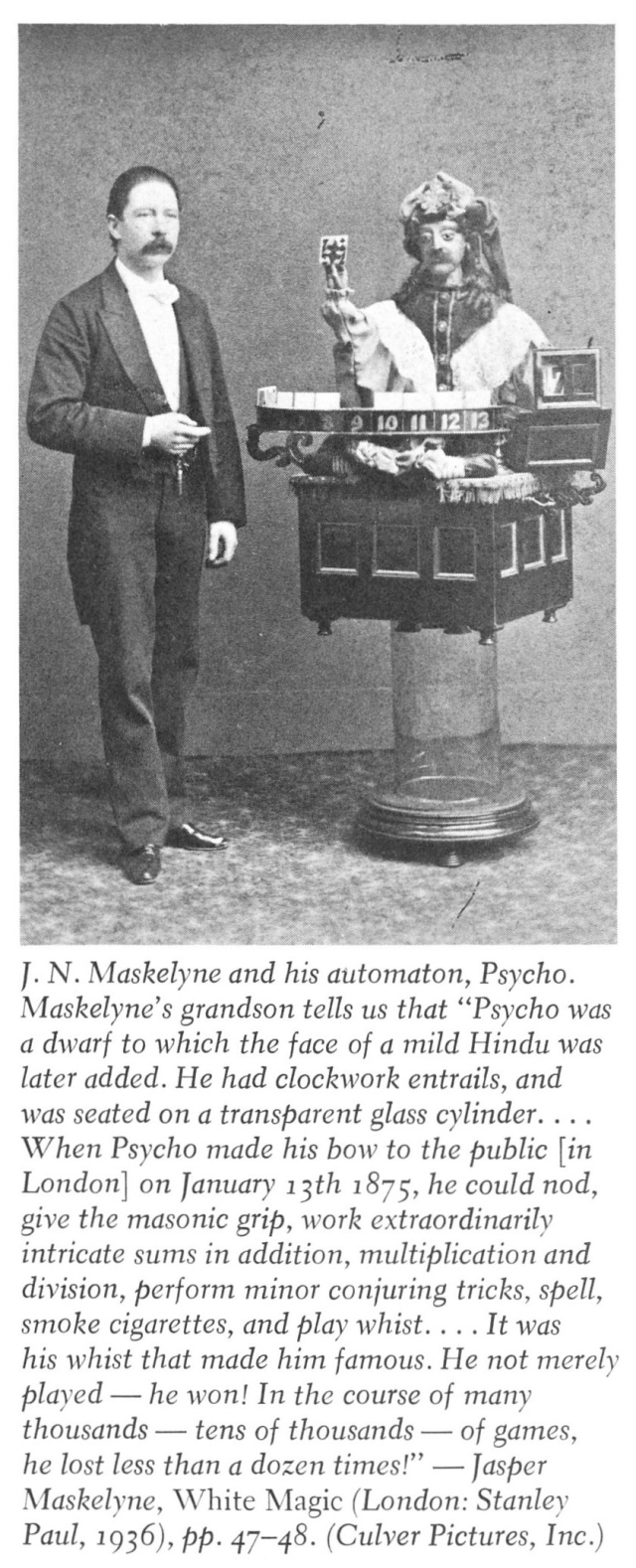
Side-by-side for an easier comparison. From what I can see externally, only the head is the same.
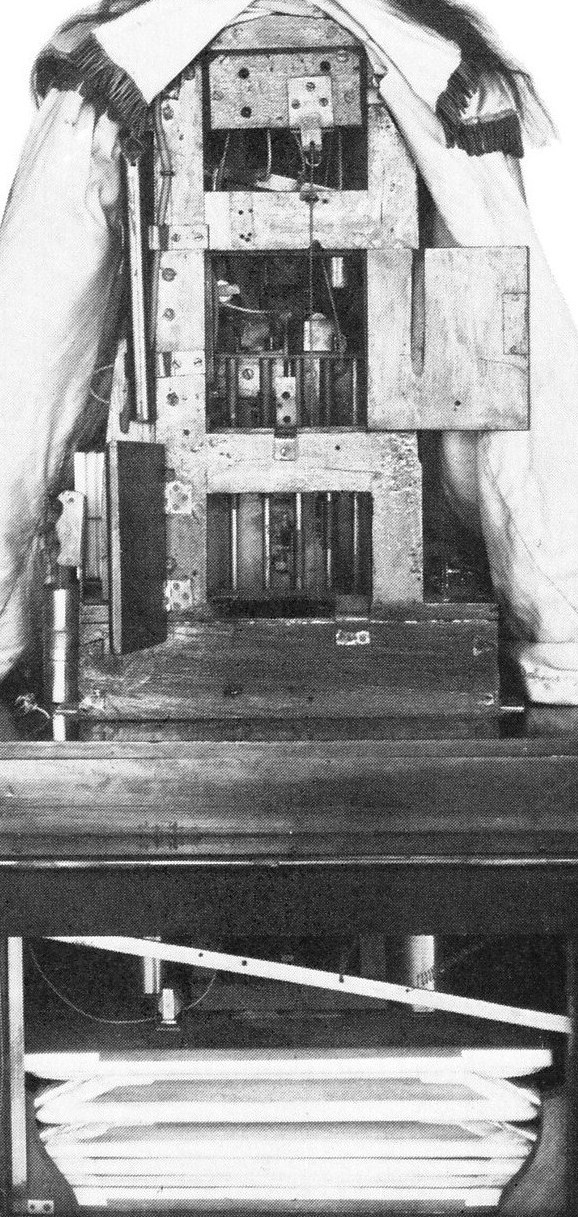
l
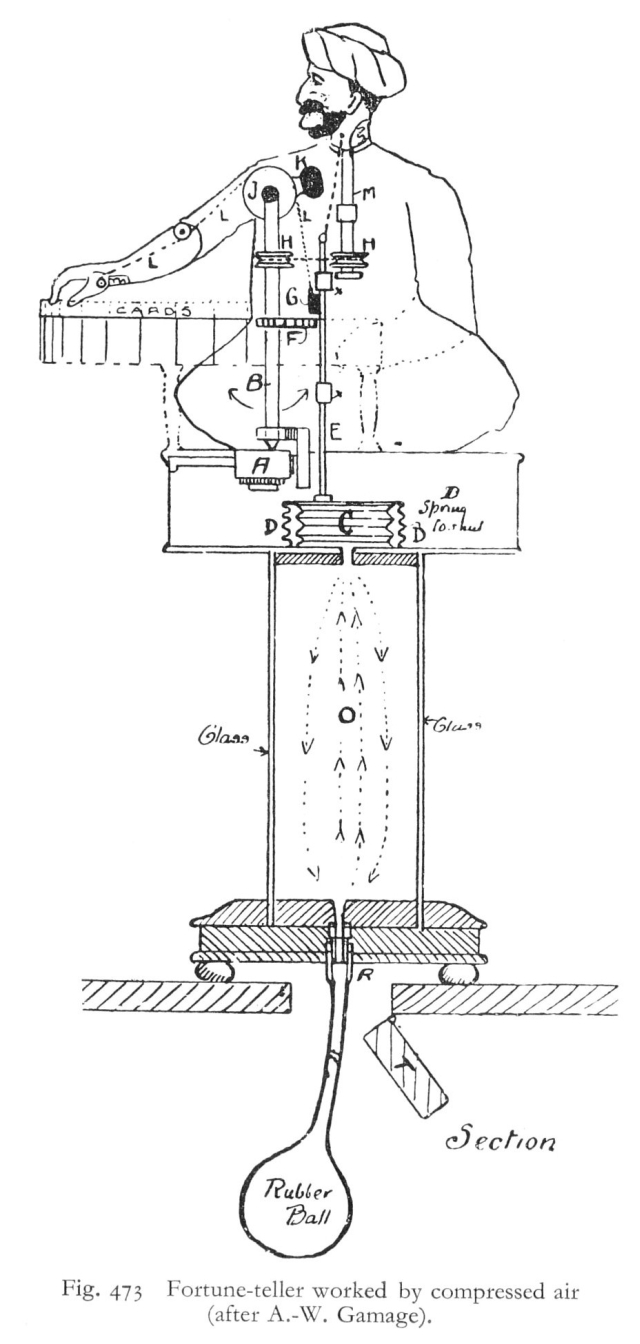
(From Automata, Chapuis & Droz – 1958 English Translated Alec Reid)
Several sham automata are operated from a distance by compressed air, and the card-player shown in figure 473 is an example of this.
A platform with a large cylinder of clear glass on top of it is brought on to the stage, then the automaton is shown to the public and is placed on a glass cylinder to make it seem completely isolated from any outside communication. But an assistant under the dais attaches a tube connected to a large rubber bulb, and by pressing this, he increases the air pressure in the whole machine through the glass tube visible to the audience. Inside the card-player's body is a bellows, which fills up under the increased pressure, and one can easily imagine how this mechanical movement will make the imitation card player work.
A clock-work mechanism, A, works continuously while pulling in one direction or the other a vertical axis, B, which controls the position of the player's arm on the table and in the area where the cards are laid out. The clock-work movement also connects with the head by the pulleys, H, and the axle, M.
When the bulb is squeezed, the head and the arm turn slowly in the required direction, but as soon as it has been emptied the bellows, C, allows the rod, E, to come down, and a key, G, which is attached to it, engages the teeth of a segment F, which is carried by the axle for the arm. This is stopped at exactly the desired place. When the rod, E, drops, it pulls the cord, L, which is stretched and moves the thumb of the automaton's hand so that it grips the card selected.
The assistant under the stage receives his instructions through a speaking-tube, into which speaks a commentator, who is hidden from the public and is following the game with opera glasses. The spectators have no idea at all how such an ingenious deceit is contrived.
Excerpts from Ancient and Modern Magic.
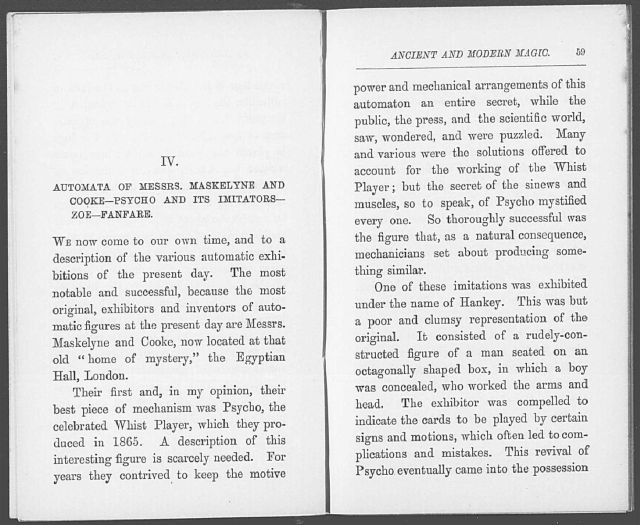



Ancient and Modern Magic by Aprey Vere, 1879 here and here.
Excerpts from Goldston's 1912 book Exclusive Magical Secrets.
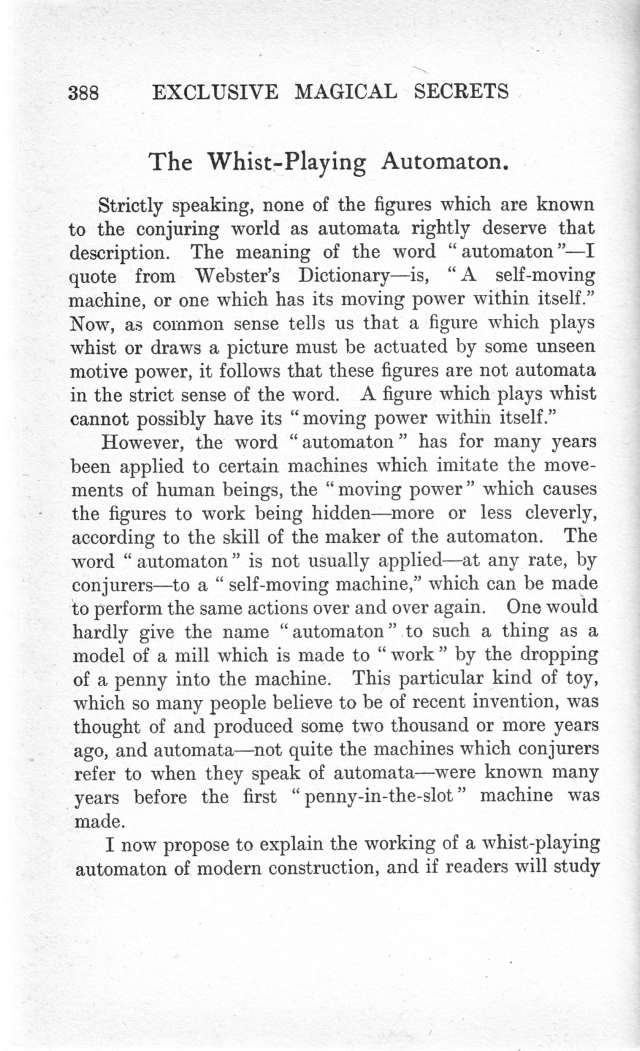


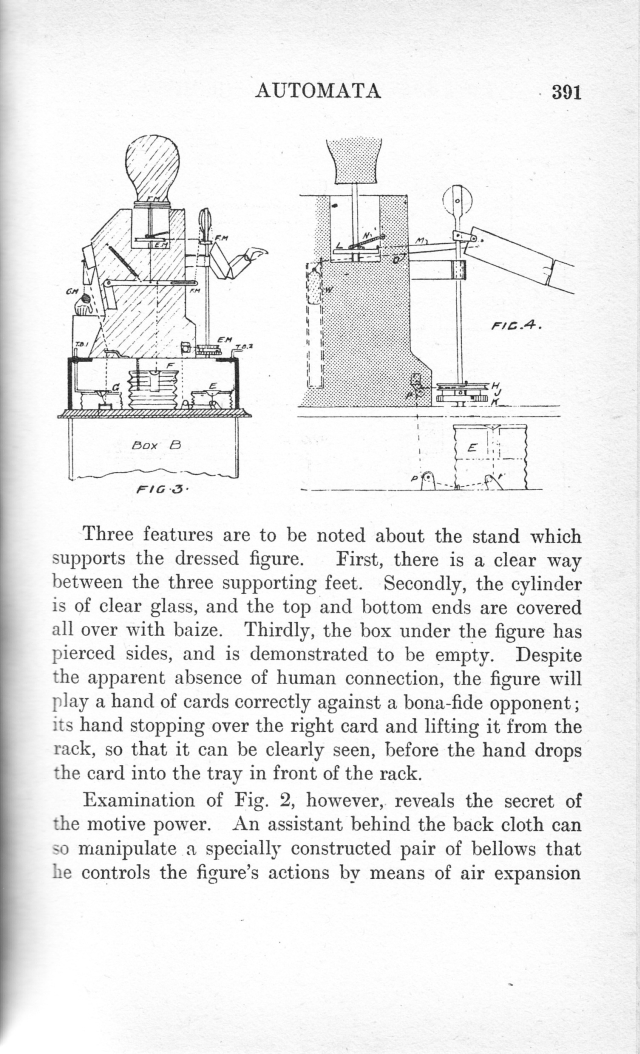
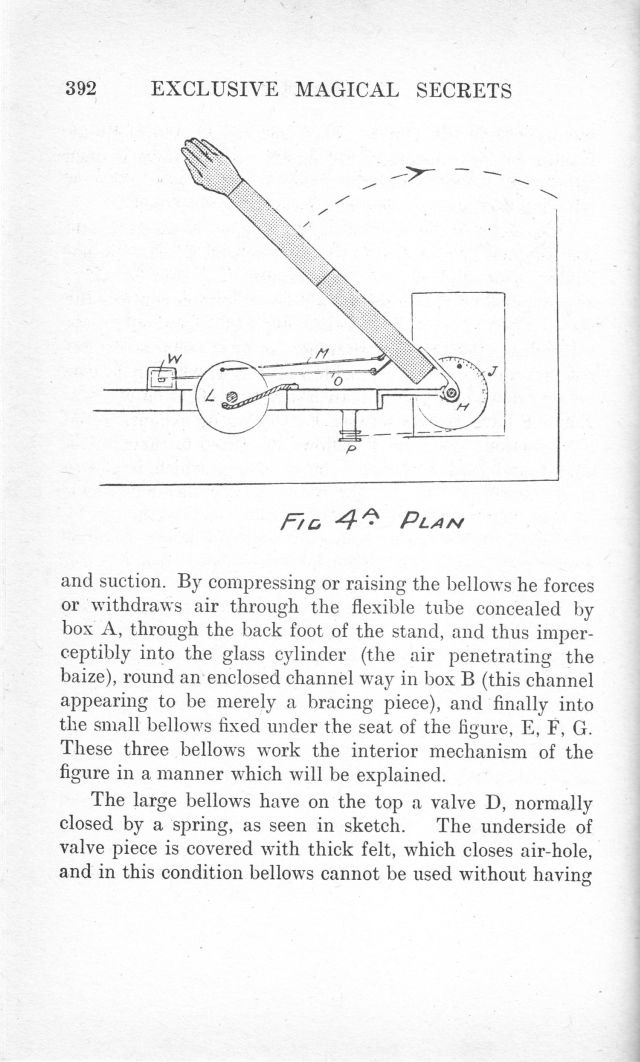
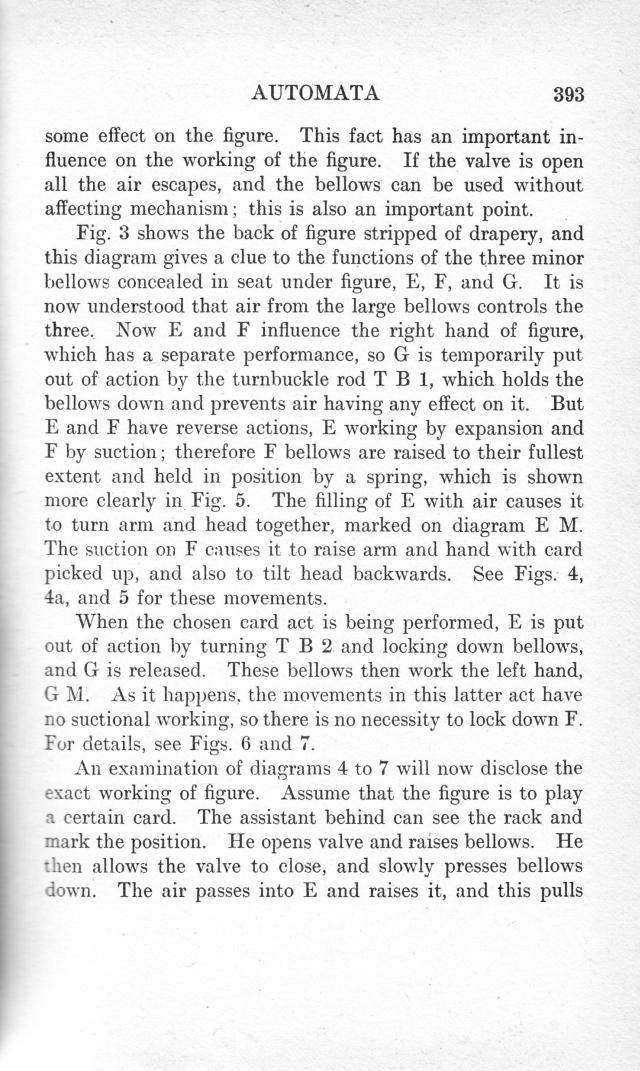
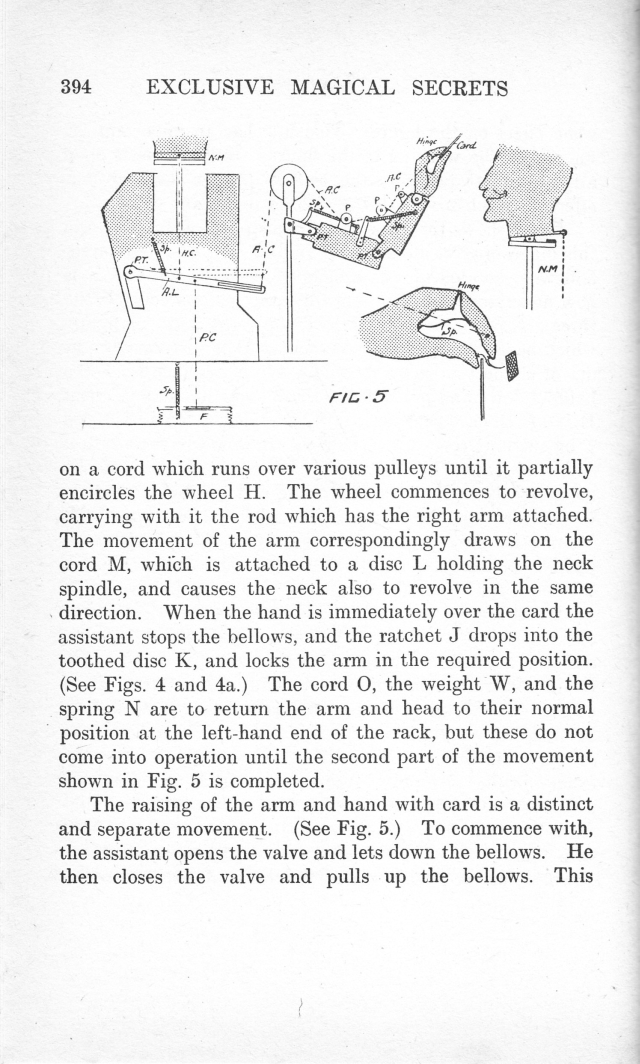
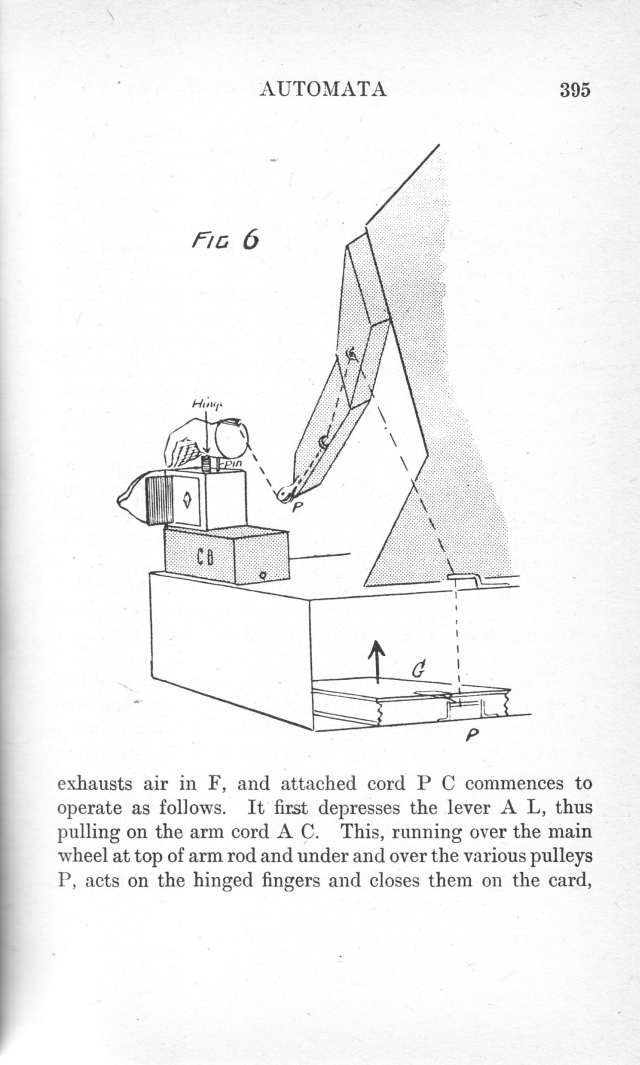
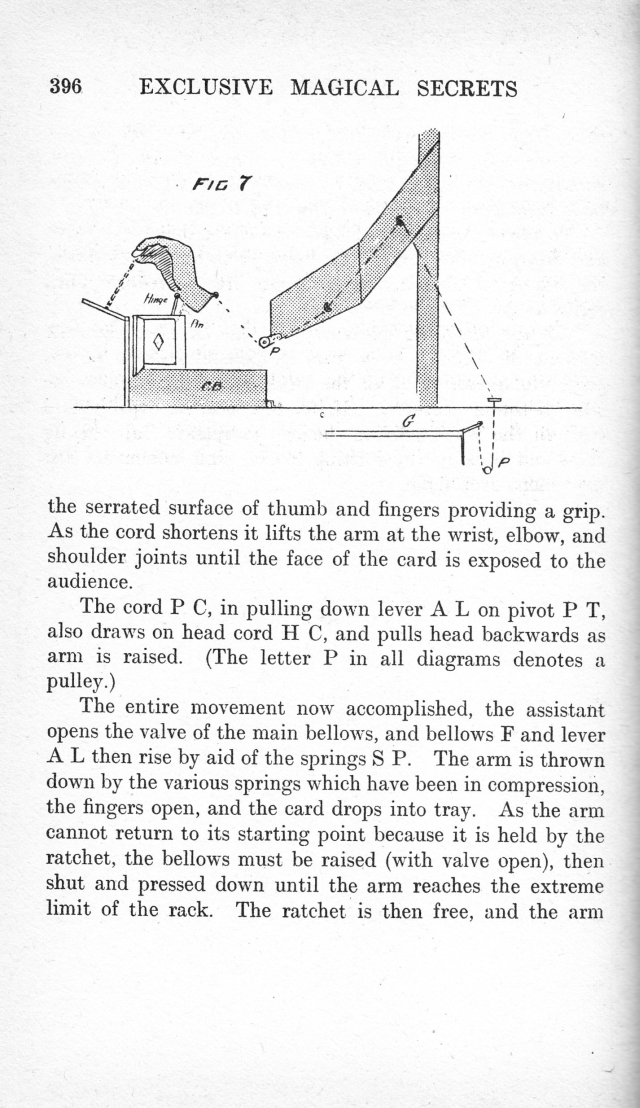
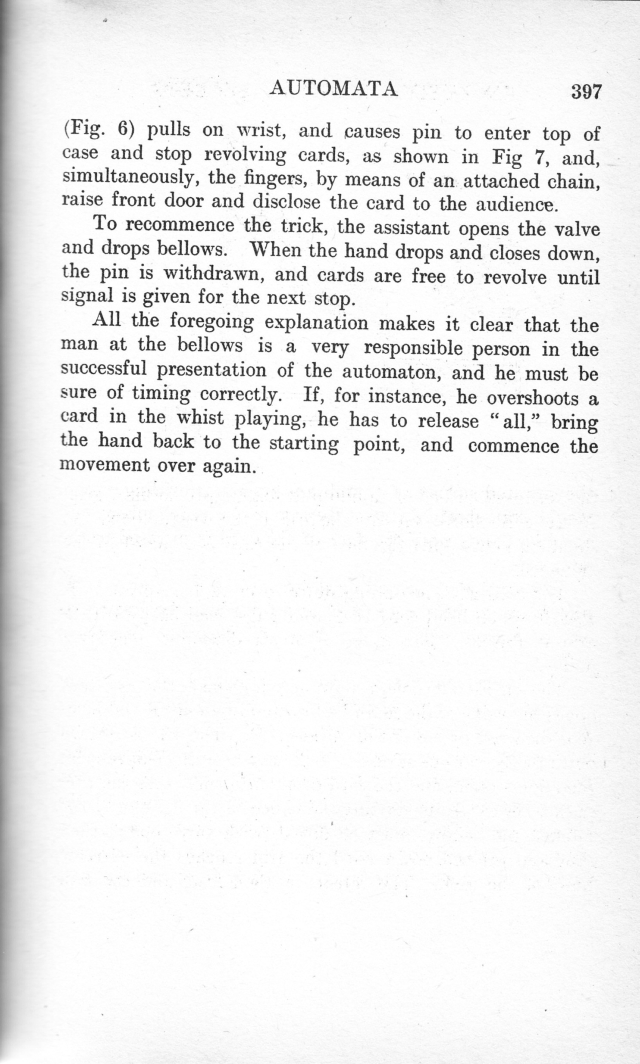
See the full chapter on Automata in Exclusive Magical Secrets by Will Golston, 1912 here.
extract from 1902 Encyclopedia White Magic
WHITE MAGIC. Under this head is included the art of performing tricks and exhibiting illusions by aid of apparatus, excluding feats of dexterity in which there is no deception, together with the performances of such automaton figures as are actuated in a secret and mysterious manner.
Among the most meritorious and celebrated mechanical illusions have been automaton figures secretly influenced in their movements by concealed operators. In the 17th century M. Raisin, organist of Troyes, took to the French court a harpsichord which played airs as directed by the audience; but, upon opening the instrument, Louis XIV. discovered a youthful performer inside. In 1769 Baron Kempelen, of Pressburg, in Hungary, completed his chessplayer, which for a long time remained the puzzle of Europe. It was an illusion,—the merit consisting in the devices by which the confederate player was hidden in the cabinet and body of the figure, while the interior was opened in successive instalments to the scrutiny of the spectators. The first player was a Polish patriot, Worousky, who had lost both legs in a campaign; as he was furnished with artificial limbs when in public, his appearance, together with the fact that no dwarf or child travelled in Kempelen’s company, dispelled the suspicion that any person could be employed inside the machine. This automaton, which made more than one tour to the capitals and courts of Europe, and was owned for a short, time by Napoleon I., was exhibited by Maelzel after the death of Kempelen in 1819, and ultimately perished in a fire at Philadelphia in 1854. A revival of the trick appeared in Hooper’s "Ajeeb," shown a few years ago at the Sydenham Crystal Palace and elsewhere. Still more recently a chessplaying figure, "Mephisto," designed by Gumpel, has been on view. No space exists for the accommodation of a living player within; but, as there is no attempt at isolating the apparatus from mechanical communication through the carpet or the floor, there is nothing to preclude the moving arm and gripping finger and thumb of the figure from being worked by any convenient connexion of threads, wires, rods, and levers. In 1875 Maskelyne and Cooke produced at the Egyptian Hall, in London, an automaton whist-player, "Psycho," which, from the manner in which it is placed upon the stage, appears to be perfectly isolated from any mechanical communication from without; there is no room within for the concealment of a living player by aid of any optical or other illusion, and yet the free motions of both arms, especially of the right arm and hand in finding any card, taking hold of it, and raising it or lowering it to any position and at any speed as demanded by the audience, prove that the actions are directed from without. The arm has all the complicated movements necessary for chess or draught playing; and Psycho calculates any sum up to a total of 99,000,000. What the mysterious means of connexion are has not been discovered ; or, at any rate, down to the time of writing this article there has appeared no correct imitation of this joint invention of John Nevil Maskelyne and John Algernon Clarke. Perhaps a still more original automaton is Maskelyne’s figure "Zoe," constructed in 1877, which writes and draws at dictation of the audience, yet cannot have a living person within, and could not be more completely severed from all conceivable means of control without. "Zoe," a nearly life-size but very light doll, sits loose upon a cushioned skeleton-stand, of which the solid feet of the plinth rest upon a thick plate of clear glass laid upon the floor-cloth or carpet of the stage. "Psycho," a smaller Oriental figure, sitting cross-legged on a box, is supported by a single large cylinder of clear glass, which, as originally exhibited, stood upon the carpet of the stage, but was afterwards set loose upon a small stool, having solid wood feet; moreover, this automaton may be placed in almost any number of different ways. Thus, from the precautions observed in the isolation of Maskelyne’s automata, no current of electricity, no magnetic attraction, no hydraulic or pneumatic force can reach them, or, if it could, would not account for the many and delicate movements which they execute; and there can be no wires, threads, or hairs, passing in any direction away from the figures, seeing that persons from the audience admitted close around the figures while they are in operation could not fail to observe them. It may be mentioned that, in the same year in which "Psycho" appeared, the joint inventors patented a method of controlling the speed of clockwork mechanism by compressed air or gas stored in the pedestal of an automaton, this compressed fluid acting upon a piston in a cylinder and also upon a rotating fan when a valve is opened by "an electrical or other connexion worked by the foot of the performer or an assistant." But it is not known whether the principle obscurely described in the specification was applicable in any way to the invisible agency employed in "Psycho" or in "Zoe," or whether it had reference to some other invention which has never been realized. The whist-playing automaton is affirmed to be the only one of Maskelyne’s many subtle inventions in which he received suggestions from another person.
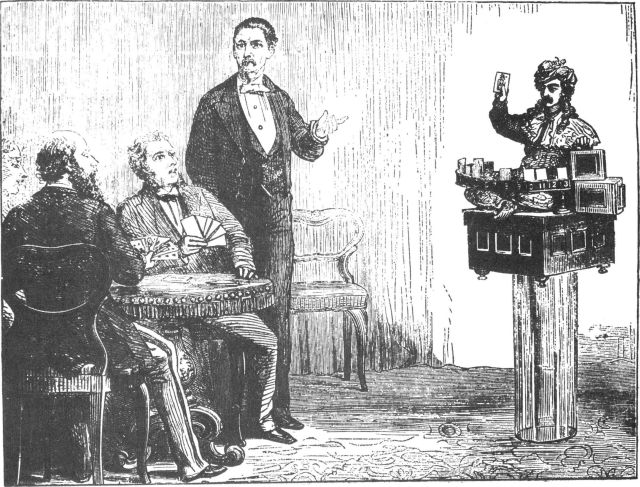
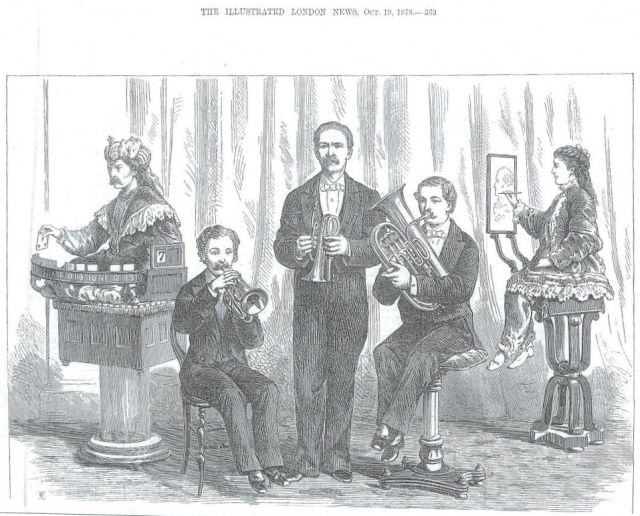
Timeline of Whist-playing Automata
1829-31 Maelzel acquired Whist-player invented by Balcom (American). There is also a suggestion that a rival chess player by the Walker brothers was eventually purchased by Maelzel and converted to a whist-player.
1873-5 Maskelyne / Clarke developed "Psycho".
1875 first showing of Maskelyne's "Psycho".
1875 December – Expose in MacMillans Jan 1876 (actually released in Dec 1875 for Christmas reading) by Dr. Pole.
Hankey (Hanky) – actual small boy hidden inside – octagonal base – later sold to Signor Boz.
1875-80 – Signor Boz (Weston) with "Yorick" the Whist-player (British)
1878 – Charles Arbre (Berlin)
Robert-Houdin (French) – "Sophos le Savant"
1877 – "Zoe" (an artist automaton by Maskelyne, not a whist-player).
???? Professor Pepper – Scynthia (Synthia)
Dr. W. H. Cremer built a psycho called "Agetos" – 1880 earliest date so far – similar to Maskelyne & Clarke's original construction.
1900 Professor Dicksonn – Theatre du Cours la Reine.
French firm built a "Psycho" for Mr. Everett. There are some suggestions that it was later purchased by Kellar. Unlikely as Kellar's did not utilize a hidden boy and Everett's probably did.
???? -The New York Journal exhibited an automaton whist-player, named the "Yellow Kid," in New York – no date.
(Some of the above information was sourced from Bradley Ewart's book "Chess: Man vs Machine".)
Some other Whist-playing Automata.
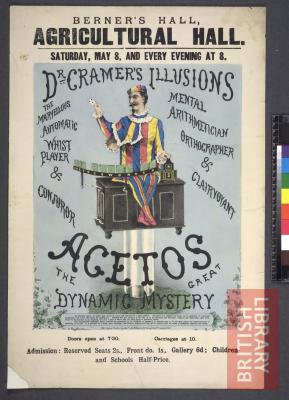
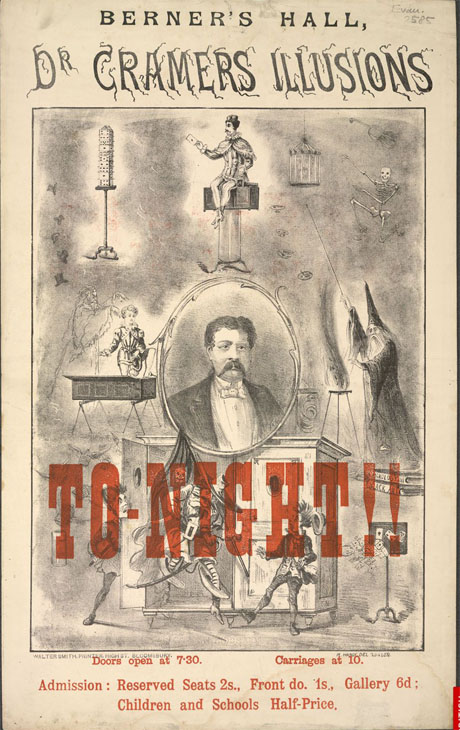
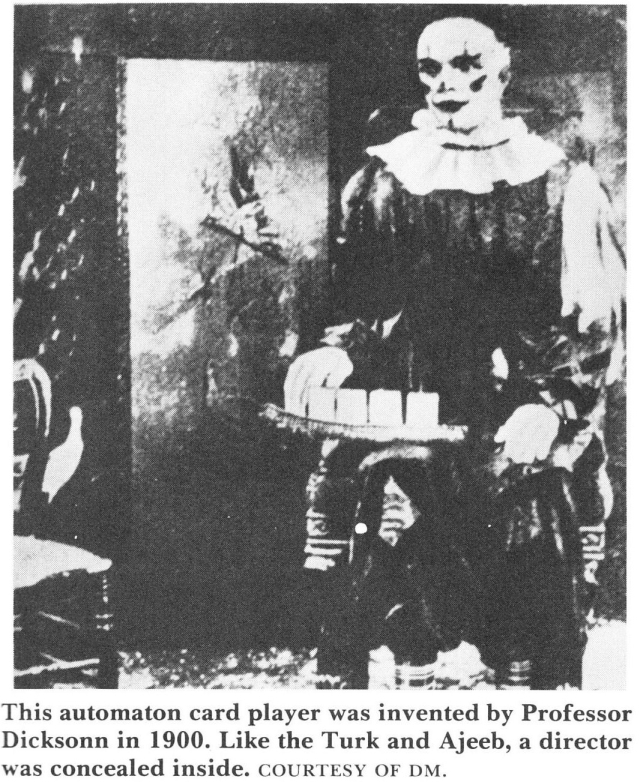

Dicksonn (Professor) My Tricks. The author is possibly A. de Saint-Genois, who published one book in Paris under the pseudonym Professor Dicksonn. The manuscript is in two parts: comprising seventeen "Drawing Room Experiments", including "The Mysterious Decanter", "Improvised Coffee", and "Neptune's Basin"; and six "Tricks for the Theatre" including "The Domino or Card Player", "The Bodiless Lady", "The Transforming Cabinet" and "The Vanishing Lady".
In 1878, Kellar returned to England and invested $12000 in new equipment, one of them being a version of Maskelyne's whist-playing automaton. Possibly A. W. Gamage's. (Gamages being suppliers of apparatus and publishers of magic related material.) A French firm built a "Psycho" for Mr. Everett. Ewart suggest that it was possibly later purchased by Kellar.
Harry Kellar was later one of Houdini's closest friends. Kellar gave Houdini "Psycho," an "automaton," while he was in California making a motion picture. When Houdini died, his collection was acquired by his brother (Hardeen), then passed on to Sidney H. Radner. Gaughan most likely purchased from Radner's Houdini collection when auctioned off in 2004.
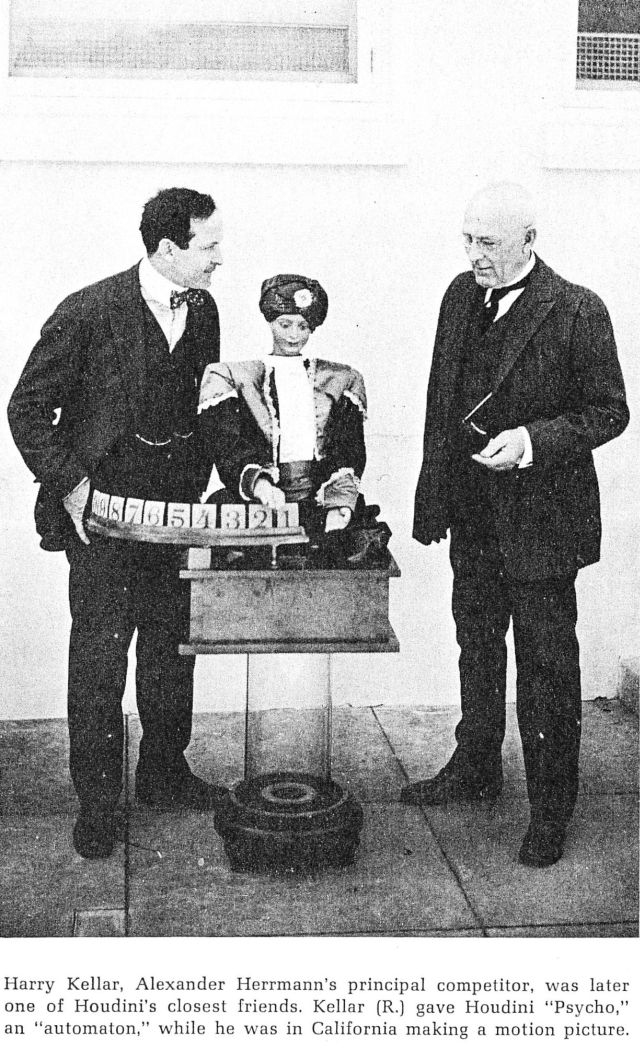

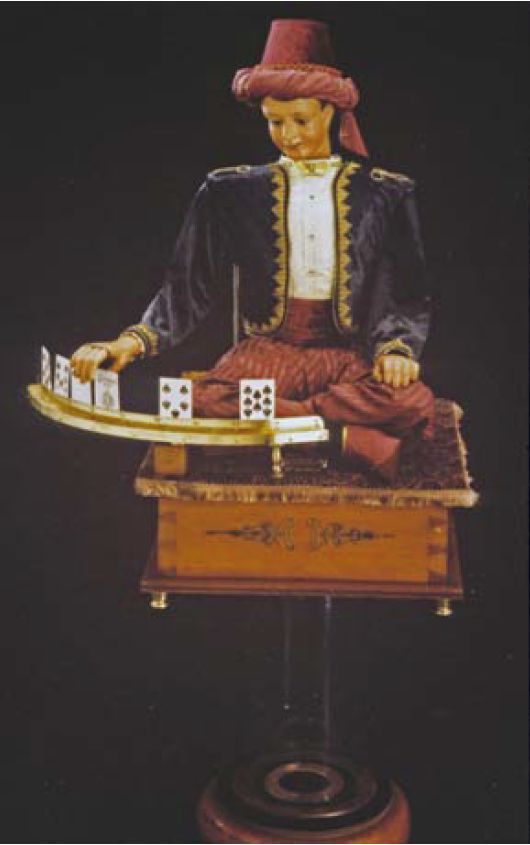
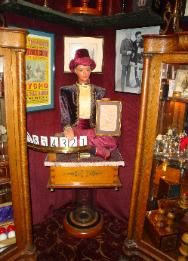
As Kellar's Psycho appears today in the John Gaughan Collection.
Thanks for your beautiful website.Have yoi some tips on “the dancing Harlequin’ performed by Robert- Houdin, Mac Allister, Heller as I onky know…..I do a search for I intend to publish it in a french Magic magazine.( Magicus)
I just thought that you might like to know that Psycho as he is seen today still shows 13 cards, but they are laid out in 3 rows now. the front row furthest away from him holds 5 cards in a slight arc, as does the second row and the third row nearest his body holds 3. The modern photographs of him don’t really show that.
Your research work on Psycho and other faux automata has helped me out a lot. Thanks so much!
Wonderful! Thank you.